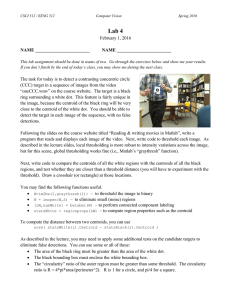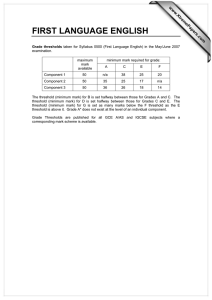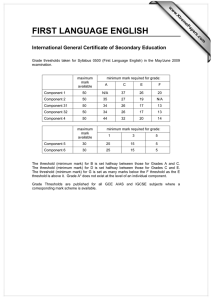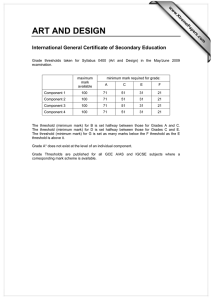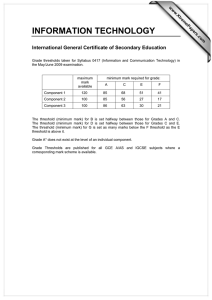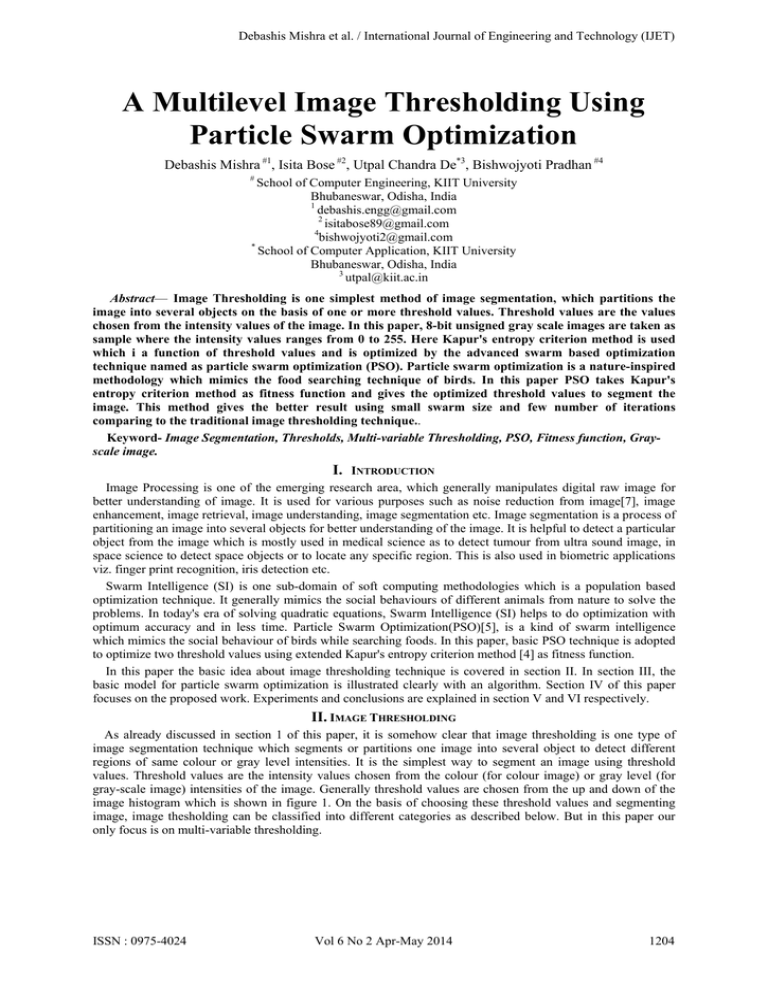
Debashis Mishra et al. / International Journal of Engineering and Technology (IJET)
A Multilevel Image Thresholding Using
Particle Swarm Optimization
Debashis Mishra #1, Isita Bose #2, Utpal Chandra De*3, Bishwojyoti Pradhan #4
#
School of Computer Engineering, KIIT University
Bhubaneswar, Odisha, India
1
debashis.engg@gmail.com
2
isitabose89@gmail.com
4
bishwojyoti2@gmail.com
*
School of Computer Application, KIIT University
Bhubaneswar, Odisha, India
3
utpal@kiit.ac.in
Abstract— Image Thresholding is one simplest method of image segmentation, which partitions the
image into several objects on the basis of one or more threshold values. Threshold values are the values
chosen from the intensity values of the image. In this paper, 8-bit unsigned gray scale images are taken as
sample where the intensity values ranges from 0 to 255. Here Kapur's entropy criterion method is used
which i a function of threshold values and is optimized by the advanced swarm based optimization
technique named as particle swarm optimization (PSO). Particle swarm optimization is a nature-inspired
methodology which mimics the food searching technique of birds. In this paper PSO takes Kapur's
entropy criterion method as fitness function and gives the optimized threshold values to segment the
image. This method gives the better result using small swarm size and few number of iterations
comparing to the traditional image thresholding technique..
Keyword- Image Segmentation, Thresholds, Multi-variable Thresholding, PSO, Fitness function, Grayscale image.
I. INTRODUCTION
Image Processing is one of the emerging research area, which generally manipulates digital raw image for
better understanding of image. It is used for various purposes such as noise reduction from image[7], image
enhancement, image retrieval, image understanding, image segmentation etc. Image segmentation is a process of
partitioning an image into several objects for better understanding of the image. It is helpful to detect a particular
object from the image which is mostly used in medical science as to detect tumour from ultra sound image, in
space science to detect space objects or to locate any specific region. This is also used in biometric applications
viz. finger print recognition, iris detection etc.
Swarm Intelligence (SI) is one sub-domain of soft computing methodologies which is a population based
optimization technique. It generally mimics the social behaviours of different animals from nature to solve the
problems. In today's era of solving quadratic equations, Swarm Intelligence (SI) helps to do optimization with
optimum accuracy and in less time. Particle Swarm Optimization(PSO)[5], is a kind of swarm intelligence
which mimics the social behaviour of birds while searching foods. In this paper, basic PSO technique is adopted
to optimize two threshold values using extended Kapur's entropy criterion method [4] as fitness function.
In this paper the basic idea about image thresholding technique is covered in section II. In section III, the
basic model for particle swarm optimization is illustrated clearly with an algorithm. Section IV of this paper
focuses on the proposed work. Experiments and conclusions are explained in section V and VI respectively.
II. IMAGE THRESHOLDING
As already discussed in section 1 of this paper, it is somehow clear that image thresholding is one type of
image segmentation technique which segments or partitions one image into several object to detect different
regions of same colour or gray level intensities. It is the simplest way to segment an image using threshold
values. Threshold values are the intensity values chosen from the colour (for colour image) or gray level (for
gray-scale image) intensities of the image. Generally threshold values are chosen from the up and down of the
image histogram which is shown in figure 1. On the basis of choosing these threshold values and segmenting
image, image thesholding can be classified into different categories as described below. But in this paper our
only focus is on multi-variable thresholding.
ISSN : 0975-4024
Vol 6 No 2 Apr-May 2014
1204
Debashis Mishra et al. / International Journal of Engineering and Technology (IJET)
Fig. 1. (A). original ultra-sound Image (B). Histogram of image A
A. Global Thresholding
In this type of thresholding only one threshold value is chosen from the image and the image is segmented
into two partitions on the basis of the chosen threshold value[3]. As we are talking about the gray-scale image
from the beginning, so we can say the gray values higher than the threshold value is recognized by one segment
and the gray values lower than the threshold value are classified into the other segment. It is illustrated in
equation 1.
I
T
( x, y )
={
1,
0,
if I (x,y) ≥ T
if I (x,y) < T
(1)
where IT(x,y) is the pixel of segmented image at (x,y) position and I(x,y) is the pixel of original image. One
example of global thresholding i clearly visible in figure 2.
Global thresholding is very easy to implement but it is capable of segment the image into only two partitions.
It may lose some sharp pixels to classify in the image whose color intensities are more similar to the other
uniquely classified pixels.
Fig. 2. Global thresholding on kiit.jpg(256×256)
Another special kind of global thresholding is available named as semi-thresholding[9] in which the
segmentation process and choosing process of threshold value are same but placing the new intensity values to
segmented image is different. Here the pixels having values more than that of threshold retain the same intensity
values as in the original image and the rest pixels i.e. the pixels having values less than threshold are given as 0.
This is shown in the equation 2. Figure 3 shows one semi-thesholding of the kiit.jpg image.
ISSN : 0975-4024
Vol 6 No 2 Apr-May 2014
1205
Debashis Mishra et al. / International Journal of Engineering and Technology (IJET)
I ( x, y ), I ( x, y ) ≥ T
IT =
I ( x, y ) < T
0,
(2)
Fig.3. Semi- thresholding on kiit.jpg(256×256)
B. Multilevel Thresholding
In the previous type of image thresholding only one threshold value is considered and the image is segmented
into two levels or partitions. That's why the type of segmentations is also known as bi-level thresholding method.
But we can also consider more than one threshold values which can segment the image into several partitions
and are referred as multilevel thresholding[3]. The numbers of segmented image is just one more than the
number of threshold values chosen i.e. if we choose three threshold values in the process then it will give four
segmented image as output. Generally in global or semi threshold it may lose some of the sharp pixels to
segment separately which are having same intensities as some of the segmented pixels. So to overcome the
above explained limitations of global thresholding, multilevel thresholds are used. This is illustrated by equation
3.
val1
I ( x, y ) = val2
val
3
T
, if
, if
, if
I ( x, y ) ≥ T2
T1 ≤ I ( x, y ) < T2
I ( x, y ) ≤ T1
(3)
Where T 1 and T 2 are two threshold values chosen, three different intensity values assigned for different cases as
shown. As here two threshold values are taken so the image can be classified into three (i.e. 2+1) segments.
C. Kapur's Entropy Based Image Thresholding
In the paper "A new method for gray-level picture thresholding using the entropy of the histogram" by J. N.
Kapur et al. [4], authors proposed a new method to threshold the image. They have shown a global thresholding
or bi-level thresholding by choosing a threshold optimized by a function defined by them recognized as Kapur's
Entropy criterion method. This method obtains the fitness value for chosen threshold value. The same method is
the sole concept of this proposed work. It is clearly illustrated in section IV.
III.
PARTICLE SWARM OPTIMIZATION
Particle swarm optimization, abbreviated as PSO, is one advanced optimization technique which is
introduced by J. Kennedy and R. Eberhart [5],[6] in the year 1995. It is a sub-domain of swarm intelligence
which mimics the social behavior of birds while searching food. It is a self organized de-centralized system
where each bird, coined as particle, follows own best value (pBest) and also follows the group best value or
global best value (gBest).
First of all some particles are initialized which are known as initial population and the number of particles
chosen are referred as swarm size. Each particles are initialized with initial assumed solutions and then
gradually all the particles change their velocities and positions according to their personal best so far and the
group or global best in current time as shown in equation 4 and equation 5. [5],[6] The best values ( pBest or
ISSN : 0975-4024
Vol 6 No 2 Apr-May 2014
1206
Debashis Mishra et al. / International Journal of Engineering and Technology (IJET)
gBest ) are obtained using a function to be optimize (i.e. maximize or minimize) . That function is known as
fitness function in swarm intelligence terminologies.
Vi t +1 = Vi t + K 1 × rand() × (Pi − X it )
(4)
+ K 2 × rand() × (G t − X it )
X it +1 = X it + Vi t +1
t
t
(5)
th
th
th
t
where V i and X i are the velocity and position of i particle in t iteration. P i is the pBest of i particle. G is the
gBest at tth iteration. K 1 and K 2 are the speed factors generally taken as 2 and rand() is the random function in
the interval [0,1]. The PSO algorithm is shown in Algorithm 1 in the further explanations.
Algorithm 1. PSO Algorithm
1. Initialize each particle
2. For each particle calculate the fitness value and personal best (pBest)
3. calculate Global Best = best among all particles
4. calculate new velocity and positions using equation 4 and 5.
5. Repeat 2 to 4 till termination criteria reach.
PSO gives better optimization result than traditional optimization methods including genetic algorithm.
Although PSO is also a population based optimization method like genetic algorithm but it does not contain
crossover or mutation as genetic algorithm contain.
IV.
PROPOSED METHOD FOR PSO BASED IMAGE THRESHOLDING
As it is already discussed that the Kapur's entropy based image thresholding is based on finding a threshold by
testing it through a function[4] defined by Kapur et al. In image segmentation using thresholding method,
generally the threshold values are approximated from image histogram which is the graphical representation of
tonal or intensities distribution as shown in Figure 1. Kapur's entropy criterion method[4] find the fitness of the
chosen threshold value using a probabilistic approach of each tonal values. It is clearly explained below.
Assume a 2D grayscale image having N numbers of pixels with gray-levels 0 to L−1 ( here L is 256 ) and ɳ i
be the number of pixels with gray level i. Then the probabilty of gray level 'i' can be found using equation 6.
pi = η i / N
(6)
Using Kapur's method [4] , now we can define the fitness function as given in equation 7. The threshold value
for which this function gives maximized fitness value is preferred.
f (t ) = F0 + F1
(7)
where F 0 and F 1 are given in the equation 8 and equation 9.
F0 = −∑i = 0
T −1
where
pi
ω0
pi
ω0
(8)
ω0 = −∑i =0 pi
T −1
F1 = −∑i =T
L −1
where
log e
pi
ω1
log e
pi
ω1
(9)
ω1 = −∑i =T p i
L −1
This function is meant for a global thresholding i.e. for a single threshold value where as the purpose of the
paper is to segment image using more than one threshold values. For that this function can be extended to
achieve multiple optimized threshold values for multilevel thresholding. This is illustrated in this section as
follows.
Let's take only two threshold values T 1 and T 2 which can segment the image into three partitions. Then we
can extend the fitness function defined earlier and is shown in equation 10 to equation 13.
fitness ([T1 , T2 ]) = F0 + F1 + F2
ISSN : 0975-4024
Vol 6 No 2 Apr-May 2014
(10)
1207
Debashis Mishra et al. / International Journal of Engineering and Technology (IJET)
pi
F0 = −∑i =1 0
T −1
where
ω0
ω0
(11)
ω0 = −∑i =0 pi
T1 −1
F1 = −∑i =2 T
T −1
1
where
pi
log e
pi
ω1
log e
pi
ω1
(12)
ω1 = −∑i =T pi
T2 −1
1
F2 = −∑i =T
L −1
2
where
pi
ω1
log e
pi
ω1
(13)
ω1 = −∑i =T pi
L −1
2
This fitness function is applied to PSO algorithm shown in Algorithm 1 for optimization process and after
successive iterations two optimized threshold values are found and the image is segmented into three partitions
using equation 3. This is illustrated clearly in Algorithm 2.
Algorithm 2. PSO based Image Thresholding
1. Input digital Image.
2. Convert image into gray-scale if image is R-G-B colour image.
3. Find Initial solutions as particles
4. Implement PSO Algorithm as shown in Algorithm 1 for number of iterations.
5. Find two optimized threshold values T 1 and T 2 .
6. Segment the image into three partitions as
a. If Image(x,y) ≥ T 2 , Then Seg(x,y) = Val 1
b. If T 1 ≤ Image(x,y) T 2 , Then Seg(x,y) = Val 2
c. Else Seg(x,y) = Val 3
V. EXPERIMENTS
There are different standard images taken into consideration in the algorithm using different swarm size and
different number of iterations in PSO. Here multilevel thresholdng is used which is shown in equation 3 and two
threshold values are optimized using a two-valued fitness function f([T 1 , T 2 ]) which can be referred from
equation 10, 11, 12 and 13. The multilevel gray-scale thresholding of image kiit.jpg is shown in Figure 4.
Fig.4. Multilevel thresholding of kiit.jpg(256×256) using proposed PSO ; (A) Original Image (B) Segmented Image
ISSN : 0975-4024
Vol 6 No 2 Apr-May 2014
1208
Debashis Mishra et al. / International Journal of Engineering and Technology (IJET)
It can be seen in Figure 4 that the image is partitioned into three section i.e. white colour region, black colour
region and gray colour region. It can be clearly visible that the windows and doors of the building in the image
is classified by black colour region. The wall of the building in the image is segmented into white colour range.
The gray colour region shows the shadow section in the image. Two threshold values are optimized using
particle swarm optimization and the process is clearly illustrated in Figure 5.
Fig.5 Optimization process of T 1 and T 2 for 30 iterations for kiit.jpg (256 × 256)
From Figure 5, it can be understood that after 17 iterations both of the threshold values shows one steady
constant values without any kind of fluctuations up to 30 iterations. The Image shown in Figure 4(B) can be
compared to the Figure 3(B) and it can be found that the multilevel thresholding of one image is more
meaningful representation than the global thresholding.
A standard gray-scale image (i.e. cameraman.jpg) can be taken to illustrate the need of multilevel thresholding.
The same image is input to the global thresholding and to the multilevel thresholding using particle swarm
optimization. The segmented result for global thresholding is shown in Figure 6 and the variation of threshold
value along the successive iterations is shown in Figure 7.
Fig 6. Global Thresholding using PSO; (A) Original Image (B) Segmented Image (failure)
ISSN : 0975-4024
Vol 6 No 2 Apr-May 2014
1209
Debashis Mishra et al. / International Journal of Engineering and Technology (IJET)
Fig 7. Optimization process of Threshold value for 30 iterations for cameraman.jpg (256 × 256)
From Figure 6, It is clear that the segmentation process using single threshold value fails in the particular
image where as the threshold values is optimized very quickly in about 6 iterations only. So global thresholding
model for segmentation fails in the particular situation. The image is applied to the multilevel thresholding using
PSO i.e. the proposed work and the output is shown in Figure 8 and the variation of threshold values are shown
in Figure 9.
Fig 8. Multilevel Thresholding using PSO; (A) Original Image (B) Segmented Image
ISSN : 0975-4024
Vol 6 No 2 Apr-May 2014
1210
Debashis Mishra et al. / International Journal of Engineering and Technology (IJET)
Fig 9. Optimization process of T 1 and T 2 for 30 iterations for cameraman.jpg (256 × 256)
Now it can observed in Figure 8 that in multilevel thresholding the image is segmented into more meaningful
way and the optimized threshold values (T 1 and T 2 ) are obtained after 23 iterations.
VI.
CONCLUSIONS
In this paper, proposed multilevel thresholding using PSO finds optimized threshold values using Kapur's
entropy method[4] and segments the image with better result comparing to global thresholding. It also finds
optimized threshold values which are close to the accurate and yields better result. But it is not easy to find the
best threshold values in traditional threshold choosing techniques. The future works consist of segmenting
colour images into different colour regions considering colour intensities.
REFERENCES
[1]
M. Sezgin and B. Sankar. Survey over image thresholding techniques and quantitative performance evaluation. Journal of Electronic
Imaging, Vol. 13(1):146–165, 2004.
[2] S. P. Duraisamy and R. Kayalvizhi. A new multilevel thresholding method using swarm intelligence algorithm for image segmentation.
Journal of Intelligent Learning System and Applications, pages 126–138, 2010.
[3] R. C. Gonzalez and R. E. Woods. Digital Image Processing. Pearson Prentice Hall, 3rd edition, 2009.
[4] J. N. Kapur, P. K. Sahoo, and A. K. C. Wong. A new method for gray-level picture thresholding using the entropy of the histogram.
Computer Vision Graphics Image Processing, 29:273–285, 1985.
[5] J. Kennedy and R. Eberhart. Particle swarm optimization. IEEE, pages 1942–1948, 1995.
[6] J. Kennedy and R. Eberhart. Particle swarm optimization, developments, applications and resources. IEEE, 2001.
[7] D. Mishra, I. Bose, M. N. Das and B. S. P. Mishra. Detection and reduction of impulse noise in RGB color image using fuzzy
technique. In N. Raja, editor, Distributed Computing and Internet Technology, volume 8337, pages 299–310, KIIT University,
Bhubaneswar, February 2014. ICDCIT, Springer.
[8] N. Ostu. A thresholding selection method from gray-level histograms. IEEE Transaction on systems, Man and Cybernetics, 9(1):62–66,
1979.
[9] G. X. Ritter and J. N. Wilson. Handbook of Computer Vision Algorithms in Image Algebra. CRC Press, Boca Raton London New
York Washington, D.C., 2nd edition, 2001.
[10] P. K. Sahoo, S. Soltani, and A. K. C. Wong. A survey of thresholding techniques. Computer Vision, Graphics and Image Processing,
41(2):233–260, 1998.
ISSN : 0975-4024
Vol 6 No 2 Apr-May 2014
1211

